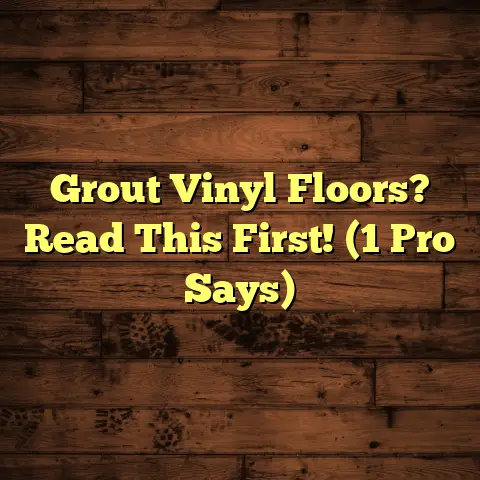Can Odor Penetrate Interlocking Luxury Vinyl Plank Flooring? (Explained)
I remember the first time I stepped into a home with interlocking luxury vinyl plank (LVP) flooring. The sunlight streamed in, highlighting the beautiful wood-like finish. It was hard to believe it wasn’t real hardwood. Yet, as I admired the aesthetics, I couldn’t help but wonder—could odors permeate this flooring?
As a flooring contractor with years of experience, I’ve encountered various challenges, and odor penetration is one that comes up more often than you’d think. It’s a topic that deserves a closer look because, let’s face it, nobody wants their beautiful new floors to start smelling like last week’s leftovers or wet dog.
Understanding Odor Penetration
Odor penetration in flooring can be influenced by several factors, including the material of the flooring, how it was installed, and the environment in which it’s placed. Interlocking LVP is designed to be durable and water-resistant, but does that mean it’s also resistant to odors?
In my experience, LVP typically has a protective layer that helps keep moisture and odors at bay. However, this doesn’t mean it’s entirely immune. If spills aren’t cleaned up promptly, or if the subfloor is damp, odors can seep through.
Factors Affecting Odor Retention
- Installation Quality: An important aspect to consider is how well the flooring was installed. If there are gaps or poor seams, odors might have an easier time making their way through.
- Subfloor Condition: The condition of the subfloor plays a significant role. If you’re installing LVP over an old carpet or an untreated wooden floor, you might be inviting odors into your space.
- Type of Odor: Some odors are more persistent than others. For example, pet urine can deeply penetrate various materials, while food spills might not linger as long if cleaned quickly.
My Experiences with Odor Management
I’ve worked on many projects where odor was a concern—particularly in homes with pets or heavy foot traffic. Here’s a story from one project that highlights some of these challenges.
A Case Study: The Pet-Friendly Home
I was called to a lovely suburban home where the owners had just installed interlocking LVP in their living room and dining area. They were thrilled with the look but quickly discovered that their two Golden Retrievers had a habit of leaving behind “presents.” The smell was not only unpleasant but also seemed to cling to the floor.
After assessing the situation, I realized that while the LVP itself was resilient, the subfloor had absorbed some of the odors due to previous accidents. To fix this, we first had to clean the subfloor thoroughly.
I recommended using an enzyme cleaner specifically designed for pet odors, which worked wonders in breaking down the smell. After cleaning, I installed a moisture barrier before laying down the LVP again. This added layer helped prevent any future odors from seeping through.
Tips for Preventing Odor Penetration
From my experiences, here are some actionable tips:
- Choose High-Quality Flooring: Not all LVP is created equal. Look for brands that emphasize odor resistance in their marketing.
- Install a Good Underlayment: A quality underlayment can provide an additional barrier against moisture and odors.
- Regular Maintenance: Regularly clean your floors with appropriate cleaners designed for LVP. Avoid harsh chemicals that could damage the surface.
- Promptly Address Spills: The sooner you clean up any spills or accidents, the less likely they are to cause lingering odors.
- Ventilation: Ensure your space is well-ventilated to help dissipate any trapped odors.
Cost Considerations with FloorTally
When it comes to managing costs during flooring installation, having a reliable tool like FloorTally can be invaluable. For example, while working on that pet-friendly home, I used FloorTally to estimate costs accurately and ensure we included all necessary materials—like the enzyme cleaner and underlayment—without exceeding the budget.
FloorTally helped me pull local material rates and labor costs into one straightforward estimate. This level of detail not only streamlined budgeting but also helped me communicate effectively with my clients about what to expect financially throughout the project.
Comparing Options: LVP vs. Other Flooring Types
You might be wondering how interlocking LVP stacks up against other flooring options regarding odor resistance. Here’s a quick comparison based on my experiences:
- Tile: Tile is generally more resistant to odors due to its non-porous nature; however, grout lines can harbor smells if not maintained regularly.
- Laminate: Similar to LVP, laminate can absorb odors if spills aren’t cleaned up quickly. However, it typically lacks some of the moisture resistance that high-quality LVP offers.
- Hardwood: Real wood can absorb odors more readily than both laminate and LVP. Once it absorbs an odor, it can be challenging to eliminate without refinishing.
While each type has its pros and cons, I have found LVP often strikes a balance between aesthetics, durability, and maintenance ease—especially in homes where spills and accidents are more common.
Maintenance Tips for LVP
To keep your interlocking luxury vinyl plank floors looking and smelling fresh, consider these maintenance tips:
- Daily Cleaning: Sweep or vacuum daily to remove dirt and debris that could scratch the surface or harbor odors.
- Weekly Mopping: Use a damp mop with a cleaner specifically formulated for vinyl flooring once a week.
- Avoid Excess Water: While LVP is water-resistant, excessive water can seep into seams and lead to issues over time.
- Use Rugs: Place washable rugs in high-traffic areas or near entryways to catch dirt before it reaches your floors.
- Address Moisture Issues: If you notice persistent dampness in your home, invest in a dehumidifier to control humidity levels.
Handling Odor Issues
If you do encounter odor issues despite your best efforts:
- Identify the Source: Determine if the odor is coming from underneath the flooring or from an external source.
- Deep Clean: Sometimes a deep clean is necessary; consider hiring professionals if needed.
- Replacement: In extreme cases where odors persist due to water damage or other issues, replacing sections of flooring may be necessary.
My Journey with Different Flooring Options
Throughout my career, I’ve had the opportunity to work with various types of flooring beyond just interlocking luxury vinyl plank. Each type has its unique challenges and benefits when it comes to odor management.
The Challenge of Solid Hardwood
When I first started working with solid hardwood flooring, I was captivated by its elegance and timeless appeal. However, I quickly learned about its limitations regarding moisture and odor retention. During one project in a coastal area, I installed hardwood floors in a beautiful beach house.
The owners loved their new floors until they began noticing a musty smell after heavy rains. It turned out that humidity levels were higher than anticipated, causing moisture to seep into the wood. The smell lingered despite my best cleaning efforts.
To remedy this situation, we had to install a dehumidifier and ensure proper ventilation throughout the house. It was a valuable lesson about choosing the right flooring for specific environments and understanding how moisture can affect different materials.
Laminate Flooring Adventures
Laminate flooring was another option I explored extensively. It offered affordability and ease of installation but had its own set of challenges regarding odor retention. I remember working on a rental property where the previous tenants had left behind quite a bit of mess.
After removing old carpets and installing laminate floors, I thought we were in the clear until we noticed lingering food odors from spills that had seeped into the underlayment. To combat this issue, we had to remove sections of laminate and treat the underlying surface thoroughly before reinstalling new laminate.
This experience taught me how important it is to address any potential problems before installation rather than after.
Tile Flooring Triumphs
Tile flooring has proven to be one of my favorites for odor resistance due to its non-porous nature. However, I’ve encountered projects where grout lines became problematic over time. In one instance, I worked on a restaurant that opted for tile floors due to their durability and ease of cleaning.
While they were satisfied with the initial installation, after years of heavy foot traffic and various spills in the kitchen area, we noticed some odors lingering around grout lines despite regular cleaning efforts.
To resolve this issue, we applied a specialized grout sealer that helped repel stains and moisture while making maintenance easier for staff members.
The Importance of Proper Installation Techniques
No matter which type of flooring you’re dealing with—whether it’s LVP or any other material—proper installation techniques are crucial to minimizing odor retention issues. Here are some key points I’ve learned over the years:
- Ensure Flat Subfloors: A flat subfloor is essential for preventing gaps where moisture and odors can accumulate.
- Use Quality Underlayments: Invest in quality underlayments tailored specifically for your chosen flooring type; this can provide insulation against moisture as well as sound dampening benefits.
- Seal Edges Properly: If you’re installing flooring near water sources like kitchens or bathrooms, make sure edges are sealed properly to prevent moisture intrusion.
- Follow Manufacturer Guidelines: Always adhere closely to manufacturer installation guidelines; doing so ensures warranties remain valid while providing optimal performance from your chosen product.
- Consider Environmental Factors: Be aware of environmental conditions such as humidity levels and temperature fluctuations; these factors influence both installation methods and long-term performance regarding odor retention.
Best Practices for Odor Management
As a flooring contractor who’s seen various scenarios unfold over time, I’ve developed some best practices for managing odors effectively:
- Educate Homeowners: Always take time during consultations or walkthroughs with clients to explain potential odor issues based on their flooring choice.
- Recommend Preventive Measures: Suggest preventive measures upfront—like using mats at entry points—to minimize dirt tracking into homes from outside.
- Offer Follow-Up Services: Consider offering follow-up maintenance services after installation; regular checks can help catch potential odor problems before they escalate into bigger issues.
- Foster Open Communication: Encourage homeowners to communicate any concerns they have early on; addressing problems promptly is key!
Understanding Manufacturing Processes
To further understand how interlocking luxury vinyl plank flooring stands up against odors compared to other options available on today’s market, let’s explore some manufacturing processes involved:
- Composition of LVP: Interlocking luxury vinyl plank typically consists of multiple layers—each serving specific purposes:
- Wear Layer: The outermost layer protects against scratches and stains while providing some level of odor resistance.
- Print Layer: This layer features printed designs mimicking wood or tile aesthetics.
- Core Layer: Made from PVC or WPC (wood plastic composite), this component provides stability while resisting moisture.
- Backing Layer: The bottom layer provides support and can also enhance sound insulation properties depending on composition type.
- Manufacturing Techniques: Advanced techniques like embossing and urethane coating enhance appearance while improving durability against everyday wear—and they contribute positively towards overall odor resistance too!
- Quality Control Standards: Reputable manufacturers implement strict quality control measures throughout production cycles; this ensures consistent performance standards across various batches produced—all essential factors when considering long-term investments such as new flooring systems!
A Comparative Analysis of Odor Resistance
When evaluating interlocking luxury vinyl plank flooring against other materials based solely on odor resistance capabilities:
- LVP vs. Hardwood:
- While hardwood offers beauty unparalleled by most alternatives—it doesn’t fare well when subjected repeatedly to spills without timely cleanup efforts.
- LVP excels here thanks largely due its protective outerwear layer which minimizes absorption rates significantly compared traditional wooden surfaces.
- LVP vs. Tile:
- Tile remains king when discussing non-porosity per se; however grout lines remain vulnerable spots needing extra attention post-installation.
- Comparatively speaking though—LVP wins out overall due ease-of-maintenance combined with aesthetic flexibility allowing homeowners greater design choices without sacrificing function!
- LVP vs. Laminate:
- Laminate tends toward lower price points but risks absorbing odors more easily than luxury vinyl counterparts unless properly maintained regularly.
- Therefore—it’s safe say while laminate may seem attractive financially upfront—it pays dividends investing slightly higher into good quality luxury vinyl planks long-term!
Final Thoughts on Odor Management Strategies
As I reflect on my journey through various projects involving interlocking luxury vinyl plank flooring—and other materials alike—I appreciate how crucial effective odor management strategies can prove beneficial both short-term during installations but also long-term ensuring client satisfaction thereafter!
By incorporating preventive measures early-on (like using quality underlayment), implementing best practices (like educating clients), fostering open communication channels throughout processes—I’ve positioned myself effectively meet client needs while building trust along way!
So next time someone asks if odor can penetrate interlocking luxury vinyl plank flooring—you can confidently share insights gleaned from personal experiences—offering them practical knowledge they can rely upon moving forward! What has been your experience with different flooring types?





